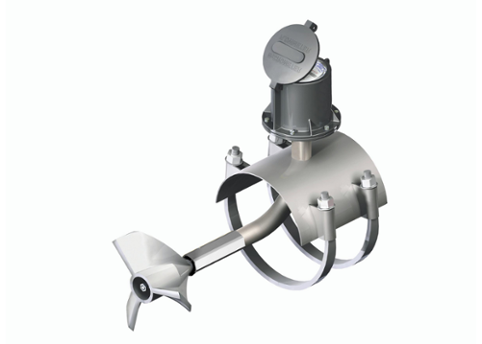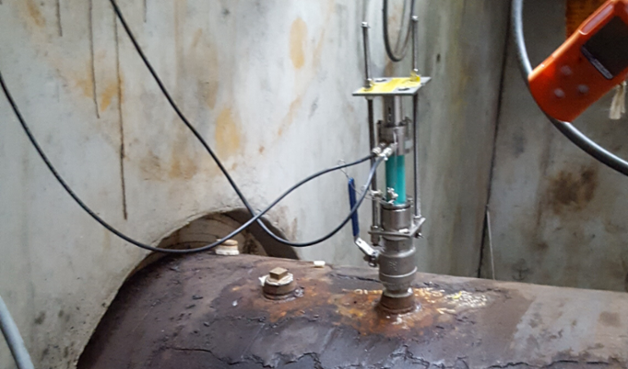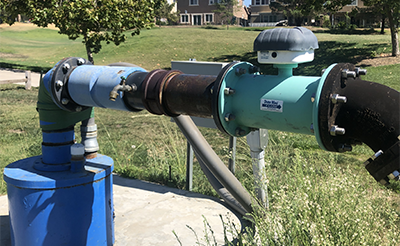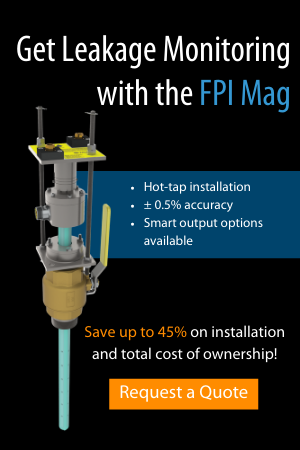Advancing Groundwater Management at the Middle Republican Natural Resources District
This article was originally published in the April 2021 issue of Irrigation Leader.
The Middle Republican Natural Resources District (MRNRD) is one of Nebraska’s 23 natural resources districts (NRDs), watershed-based local agencies that handle a wide variety of environmental issues across the state, including groundwater quantity and quality, soil erosion, and flood prevention. One of the MRNRD’s main focuses today is on groundwater management. To further this goal, it has acquired a WaterSMART grant from the Bureau of Reclamation to put updated telemetry meters on all its wells. The end goal is to provide all its farmers with real-time information on their water use, soil moisture, and other useful information. In this interview, MRNRD Manager Jack Russell and Assistant Manager Sylvia Johnson update us on the achievements of the metering program and their plans for the future.
Irrigation Leader: Please tell us about your backgrounds and how you came to be in your current positions.
Jack Russell: I was born and raised on a farm in Riverton, Nebraska. My family has lived along the Kansas-Nebraska border for as long as I know. I spent some time working in Colorado and North Dakota and came back to Nebraska 6½ years ago to work at the MRNRD.
Sylvia Johnson: I was born and raised in Alma, Nebraska, on a farm and ranch, and my husband and I farm and ranch as well. I am the assistant manager of the MRNRD. I’ve been here a little over 10 years.
Irrigation Leader: Tell us about the MRNRD.
Jack Russell: The MRNRD is one of three NRDs that cover the Republican River basin in Nebraska. We cover a little more than four counties and have about 295,000 acres of irrigated land. When the NRDs were formed in 1972, they were given taxing authority, and during the 1990s, the NRDs were given statutory authority related to groundwater management. In 1998, a lawsuit was filed related to the Republican River Compact between Colorado, Kansas, and Nebraska, and after the Supreme Court ruled on the matter in 2002, one of the final settlement stipulations was for the NRDs in the Republican River basin to put meters on all irrigation wells.
Irrigation Leader: How much groundwater can your irrigators use in a season?
Jack Russell: Right now, groundwater irrigators have an allocation of 12 inches a year, spread out over a 5-year allocation period, meaning that they can use 60 inches over 5 years. If they don’t use their entire allotment during the 5-year allocation period, they can carry over 1 year’s allocation, giving a potential maximum of 72 inches in an allocation period. Most of our water users manage their water well enough that they usually carry water over from each allocation period. Irrigation Leader: Please tell us about your metering project.
Jack Russell: Our current WaterSMART grant is going toward installing telemetry meters on all wells in the rapid response area of the MRNRD. In the early years, when the moratorium on increases in consumptive use from irrigation was put on, we installed over 2,600 meters. These meters allowed us to monitor and certify how much irrigation water was being used. Over the last several years, the MRNRD has shifted from regulating groundwater to helping our producers come up with ways to manage and reduce their water use. Our first WaterSMART grant was submitted and approved in 2019. It was preceded by two water sustainability grants from the State of Nebraska. These grants were successful in helping to expand the high-tech metering project that involved monitoring soil moisture.
Sylvia Johnson: The goal of the high-tech irrigation project is to help our producers be more efficient managing their water. Efficiency is a core part of having a sustainable water source. We believe that if we give our farmers more tools in their toolboxes, they will be able to use their water more efficiently, which will in turn help the MRNRD in the long term.
We have been working with Seim Ag Technology on all these projects. When we asked for proposals for this project, the McCrometer company showed us its products, and we decided that they were a good fit because our existing meters were also made by McCrometer. This project will provide more frequent data for timely water management decisions. FlowConnect meters are able to collect and transmit flow from the meters to our in-house servers. These meters offer automated data collection to provide accurate and reliable information for water resource management.
The MRNRD has been successful in applying for grants and in being able to provide cost-share funding to the producers for this real-time telemetry. This technology, which provides information on rainfall, pressure readings, flow readings, and soil moisture levels, helps them better manage their irrigation water. They can use it to set up alarms on their systems to alert them of major rain events. These systems have been popular among the producers because the new technology has helped them adjust their irrigation to actual needed usage.
Jack Russell: These initial high-tech irrigation systems measure how much water is being applied as well as rainfall, pressure, and soil moisture. They transmit all this information via telemetry to a server that is accessible both to the producers and to the MRNRD. The producers can see in real time how rainfall affects their soil moisture and whether more water is needed. The technology is user friendly, and the graphics are easy to interpret. McCrometer is working on an app to allow access to that same information on phones.
After the first 2–3 years, we noticed that anybody who was using this system was using around 10 percent less water than they were before the systems were installed. Even 10 percent is a lot, especially if we can reach half the users within our 295,000 irrigated acres. We have also worked with CropMetrics, LindseyZimmatic, and ServiTech on soil moisture monitoring.
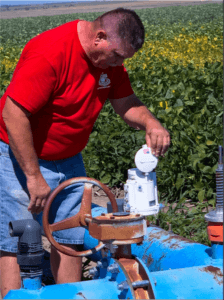
Ken Seim of Seim Ag Technology checking one of the MRNRD’s new telemetry meters.
Irrigation Leader: Approximately how many producers are working with you on this?
Sylvia Johnson: There are 100 for the high-tech soil moisture program, and this number is constantly growing.
Jack Russell: We’ve had 3 years’ worth of high-tech grants and have worked with 100 people. That is what led us to update all our meters with McCrometer as well.
When you start looking into making your district high tech, you realize that the most important first step is making sure everyone can see how much water they are applying in real time. If everybody had telemetry water meters, they would have access to that information.
We started working with Ken Quandt of McCrometer to apply for a WaterSMART grant from the Bureau of Reclamation. The WaterSMART water and energy efficiency grant program puts a lot of emphasis on water savings. We included information we had already collected on water savings from the high-tech project in the application and linked in the compact compliance portion of this by looking at the high-depletion rapid response areas with wells. We were successful in getting the grant.
We’re currently installing 1,000 McCrometer telemetry connected water meters. This project includes installing flow-straightening veins in the irrigation pipes prior to the water meters. The FS100 straightening vein eliminates water surges and other factors affecting accuracy. The NRD purchased the server, so we will control the information. Our goal is to make the information available to every producer through a password-protected login.
Access to real-time data will eliminate the need for staff to read meters every fall. These FlowConnect meters have a built-in solution for collecting and transmitting flow information from the meter to our in-house sever. These meters offer automated data collection to provide accurate and reliable information for water resource management. FlowConnect has exact-read technology that ensures an exact match from meter to website. Since the batteries for the telemetry systems last for 5 years, we will check their status and change their batteries on a rotating basis, checking 25 percent of them every year on a 4-year cycle.
Another benefit of a system like this is that we will be immediately informed if there is a problem with a meter.
So far, we have put in about 800 meters, which is a good start. We’re really excited about where the project is going. What is distinct about this project is not just that we are installing telemetry; it’s that we are creating a single, connected, consistent system. Uniformity across the district generates economies of scale. When everybody has the same meter, all the data come through the same software and are accessible at the same location.
The district is also using the WaterSMART grant to install several weather stations to monitor local weather conditions across the district for local crop water use. Irrigators will be able to match their water applications to local weather factors, as monitored and calculated by local weather stations. Then they’ll be able to match the water applications to local crop water use.
Irrigation Leader: Considering that the producers who have taken part in this program are saving an average of 10 percent of their water, are other producers contacting you to take part?
Sylvia Johnson: There is a lot of interest from other producers. Often, farmers who have one meter want to know when they can get more.
Irrigation Leader: Can they buy into the program and purchase their own meters?
Sylvia Johnson: The board has discussed that, but hasn’t settled on anything.
Jack Russell: We’re pretty busy installing the meters as we get them. We’re hoping to meet our goal of having the updated meters in the whole district within the next 3 years. The Natural Resources Conservation Service just received funds that it will be able to use through its Environmental Quality Incentives Program to target practices that match the project the NRD is implementing with its WaterSMART grant. This will coordinate with what we are doing with the meters by promoting telemetry soil moisture probes and other practices. This supportive program will help us with our groundwater management efforts.
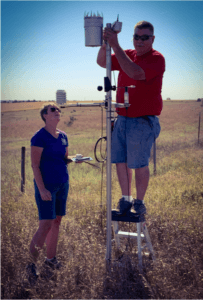
Ken and Cheryl Seim of Seim Ag Technology installing a weather station.
Irrigation Leader: What results are you seeing from this program?
Jack Russell: The first irrigation allocation started in 2005. After the drought in 2012, when the average irrigation usage was 17 inches, the board put a hard cap on water use in 2013. Every irrigator’s allocation was reduced by 20 percent. The producers in the MRNRD monitored their usage on their meters, which showed them the advantage of knowing their water application and the importance of meeting our compact with Kansas.
Our goal is to be sustainable. Everybody who is currently irrigating should be able to continue to irrigate. The goal is for everybody to be successful, both now and long into the future. Most of these farmers have GPS on their tractors, planters, and sprayers, and we’re trying to give them the tools to help them now so that they are in even better shape.
Irrigation Leader: What are the immediate goals of your program?
Jack Russell: We’re working with Ken Quandt of McCrometer to apply for another WaterSMART grant for 1,000 more meters. We have successfully accessed funds from the Nebraska Department of Natural Resources’ Water Resources Cash Fund. It is paying for part of this WaterSMART grant. If we can cover the next 1,000 meters with the next WaterSMART grant, we’ll be able to finish it off within a couple of years. The ultimate goal is for every producer to have an app on their phone that tells them how much water they’re using and what their soil moisture is. McCrometer’s app for FlowConnect, which will allow customers to get data on their phones, laptops, and other devices, will launch soon.
Irrigation Leader: What is your advice to other NRDs or irrigation districts that are considering a similar conservation metering program?
Jack Russell: The key thing is to look at the producers’ needs and to find the tools that are necessary to meet those needs. Most producers don’t aim to use all the water they can. Most users want to be good stewards of the land and to use what they have wisely. It is always easier for an NRD or district to simply regulate and allocate water and to do no more than that, but it works so much better in the big picture if you can actively help producers to improve their management.
Sylvia Johnson: It can seem overwhelming at first, and it requires time and patience, but when you get into a project like this, you know you’re doing the right thing for the producers and the district by improving the level of sustainability. Just as with everything in this world, you have to evaluate where you are and recognize what new technology can do. You have to adapt to new practices; you can’t just live in the past.
Irrigation Leader: Is there anything more you would like to add?
Jack Russell: I think we both would like to acknowledge the landowners and irrigators who will benefit from this project. Their level of interest has been extremely high, and it is exciting to be working on a project that will benefit all the irrigators in the MRNRD.
Jack Russell is the manager of the Middle Republican Natural Resources District. He can be contacted at jrussell@mrnrd.org.
Sylvia Johnson is the assistant manager of the Middle Republican Natural Resources District. She can be contacted at sjohnson@mrnrd.org. For more about MRNRD, visit mrnrd.org.
For more information on McCrometer’s technology, contact Market Development Manager Ken Quandt at kenq@mccrometer.com.
Related Posts
Featured Posts
Small Package, Big Impact: The Importance of Desiccant Cartridge Maintenance
You’ve likely seen a desiccant cartridge, in the form of the small silica gel packet accompanying food products, or the activated carbon packet at the top of pharmaceutical bottles. It’s also commonly used in electronics and near sensors, especially for...
Choosing the Right Non-Contact Flow Meters: A Quick Dive into Radar and Laser Technologies
When measuring open channel flow wastewater and stormwater, non-contact flow technology is the ideal method, able to provide an accurate velocity and flow rate. Especially in the wet weather season, non-contact flow technology greatly benefits open channel...
Meeting BABA Compliance and Expanding Opportunities
Content Recorded and Published at WEFTEC in October 2024 In this episode of The Water Online Show: On Location, (now former) McCrometer President Pete Oveson dives into the company's story and recent developments shaping its future. He begins with an overview of...
Request More Information

